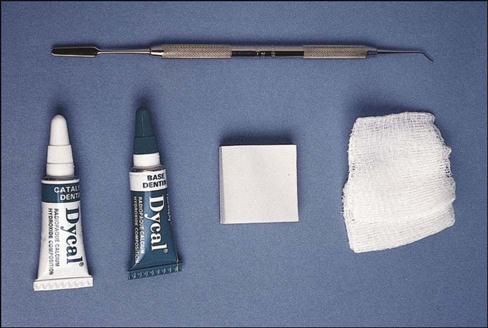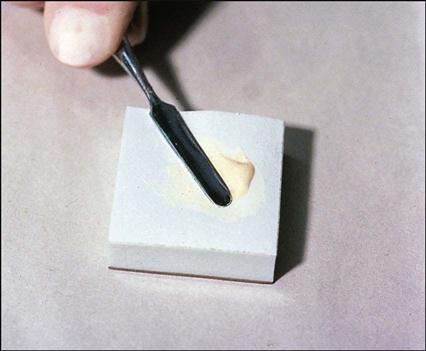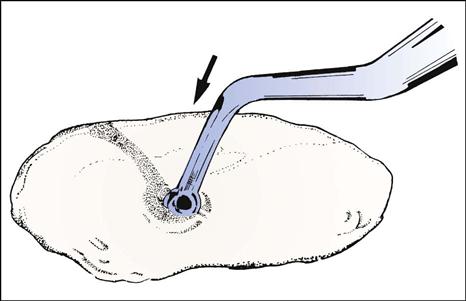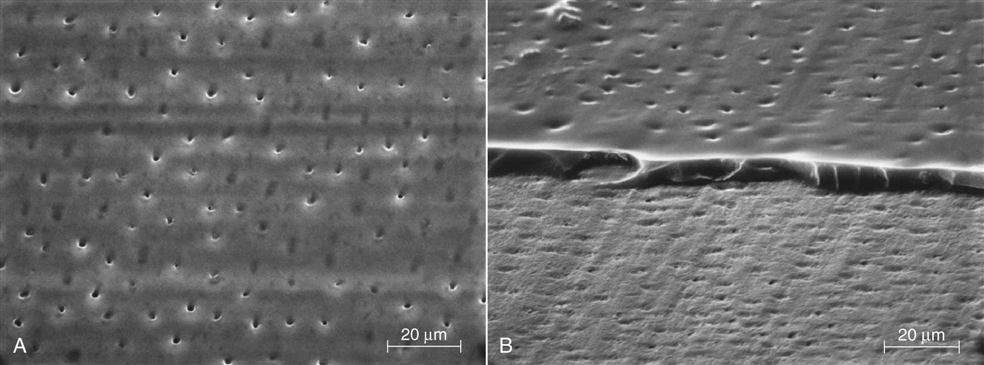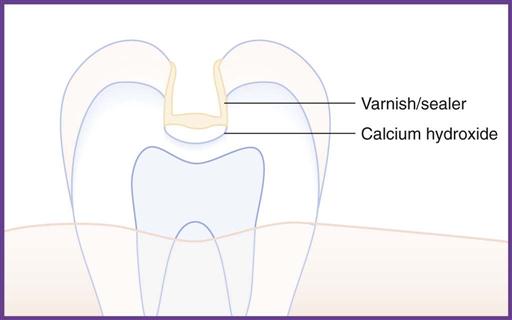Dental Liners, Bases, and Bonding Systems
Learning Outcomes
On completion of this chapter, the student will be able to achieve the following objectives:
• Pronounce, define, and spell the Key Terms.
• Discuss how and why cavity liners are used in restoring tooth structure.
• Discuss how and why varnishes are used in restoring tooth structure.
• Discuss how and why dentin sealers are used in restoring tooth structure.
• Discuss how and why dental bases are used in restoring tooth structure.
• Describe the etching process of a tooth and its importance in the bonding of tooth and material.
Performance Outcomes
On completion of this chapter, the student will be able to achieve competency standards in the following skills:
• Apply calcium hydroxide to a prepared tooth surface.
• Apply dental varnish to a prepared tooth surface.
• Apply dentin sealer to a prepared tooth surface.
• Mix and place three types of base on a prepared tooth surface.
Electronic Resources
![]() Additional information related to content in Chapter 44 can be found on the companion Evolve Web site.
Additional information related to content in Chapter 44 can be found on the companion Evolve Web site.
Key Terms
Desiccate (DES-i-kayt) To remove all moisture from an item, or to dry out.
Etchant (ECH-unt) Chemical agent used to prepare a tooth surface for a dental material.
Etching (ECH-ing) Process of cutting into a surface with the use of an acid product.
Eugenol (YOO-je-nol) Colorless liquid made from clove oil and used for its soothing qualities.
Hybrid (HYE-brid) Material that produces a similar outcome to its natural counterpart.
Insulating Preventing the passage of heat or electricity.
Micromechanical (mye-kroe-me-KAN-i-kul) Means by which a material and a structure lock onto one another through minute cuttings.
Obliterating (oe-BLIT-uh-rayt-ing) Removing something completely.
Polymerize (pah-LIM-uh-rize) To subject a material to the bonding process of two or more monomers.
Sedative (SED-uh-tiv) Having a soothing effect.
Smear layer Very thin layer of debris on newly prepared dentin.
Thermal (THUR-mul) Relating to heat.
A variety of supplemental dental materials are included in a restorative and esthetic procedure for the health and well-being of the tooth that is being restored. This chapter describes these materials and guides you in the use of liners, bases, varnishes, desensitizers, and etching and bonding materials that provide added protection for the pulp and surrounding tooth structures in the final restoration process.
When a dentist begins to prepare a tooth, he or she is never 100 percent certain as to the extent of disease present in the tooth’s structure until the tooth has been accessed by a rotary or hand cutting instrument. If decay has extended into the dentin or has moved close to the pulp, a moderately deep or deep preparation is required. When this happens, the tooth will require additional materials to be placed, such as a liner, base, varnish, desensitizer, or bonding agent or a combination of the five, before the permanent restoration is placed.
Table 44-1 summarizes the use of supplementary materials discussed in this chapter and presents the order in which they would be placed for specific procedures.
TABLE 44-1
Supplementary Dental Materials and Application in Order of Use
< ?comst?>
| Type of Restorative Material | Shallow Preparation | Moderately Deep Restoration | Deep Restoration |
| Amalgam | |||
| Composite resin | |||
| Gold inlays/onlays |
1 Base |
||
| Ceramic |
< ?comen?>< ?comst1?>
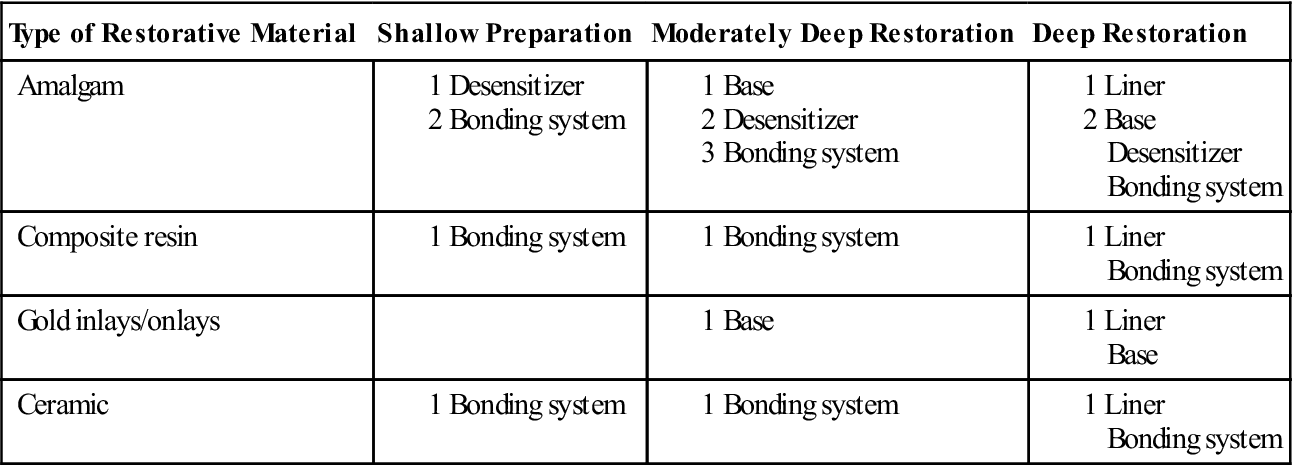
< ?comst1?>
< ?comen1?>
Prepared Tooth Structures
The types of supplemental materials selected by the dentist will determine how the tooth will be prepared. If you look at existing restorations in your mouth, you will see a specific outline or design of the restorations. These cavity designs are used for the sole purpose of creating strength within the tooth; this determines how well the tooth will hold the restoration in place. The more natural tooth structure that the dentist leaves, the easier it is to hold the restorative material in place. If the tooth structure is weak, however, or has little foundation, the dentist must rely on dental materials for their retaining properties.
Pulpal Responses
As was mentioned in earlier chapters, if decay has progressed through the enamel and into the dentin, a patient may have greater sensitivity and discomfort even after placement of a permanent restoration. The patient can experience sensitivity immediately, a month after placement, or even several months after placement. For the dentist to be proactive, he or she must decide at this point what supplemental materials will be placed to provide medication and protection against a pulpal response. The pulp responds differently to different stimuli.
Types of Pulpal Stimuli
Dental Liners
A dental liner does exactly what its name implies: It is a thin layer of material placed at the deepest portion of the dental preparation to provide pulpal protection or dentinal regeneration. This thin barrier protects the pulpal tissue from irritation caused by physical, mechanical, chemical, and biologic elements. The health and condition of the tooth being restored determine which lining agent the dentist will select.
Calcium Hydroxide
Calcium hydroxide is a frequently selected type of cavity liner because of its unique characteristics:
Application
Liners are supplied either as a two-paste system (base and catalyst) or as a light-cured material. The material is prepared before placement, and, with the use of a Dycal applicator, the liner is placed only on the deepest dentin surface of the preparation. It is important to note that this material is not to be placed on enamel or in retentive grooves of the preparation.
The expanded-functions dental assistant (EFDA), or registered dental assistant (RDA), can place dental liners if this function is legal in the state in which the assistant is practicing. Because of variations in cavity preparations, you must be certain of where the liner is to be placed. Knowledge of pulpal anatomy and knowledge of how a cavity preparation appears will assist you in your placement (Fig. 44-1). See Procedure 44-1.
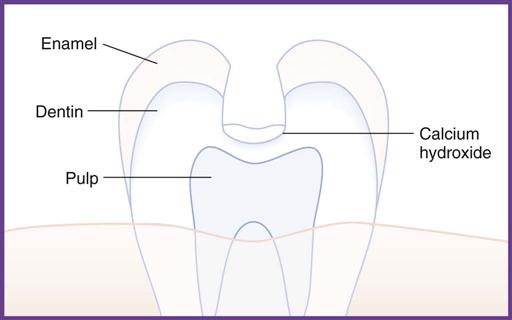
Varnish
If you are familiar with refinishing furniture, then you will understand the significance of using a varnish to protect the wood from the environment. A dental varnish works in the same way for the preparation of a tooth. Dental varnish is a liquid that consists of one or more natural resins in an organic solvent. This material is placed within the entire preparation. Application of a varnish accomplishes the following:
• Seals dentinal tubules (Fig. 44-2)
• Reduces microleakage around a restoration
• Acts as a barrier to protect the tooth from highly acidic cements such as zinc phosphate
Application
Varnish is applied with a small disposable applicator or with a cotton pellet held in sterile cotton pliers. When cotton pliers are used, care must be taken not to contaminate the remaining liquid or the bottle. It is important to note that when a liner is placed, the varnish will be placed after the liner is applied (Fig. 44-3).
Because dental varnish interferes with the bonding and setting reaction of composite resins and glass ionomer restorations, the use of varnish is contraindicated with these materials. As you read later in the chapter, you will learn about bonding agents and their role in protecting the exposed tooth surface. Today, you see more bonding agents with additional qualities that are intended to replace the use of varnish.
The EFDA (RDA) can place dental varnish if the function is legal in the state in which the assistant is practicing. See Procedure 44-2.
Stay updated, free dental videos. Join our Telegram channel

VIDEdental - Online dental courses


